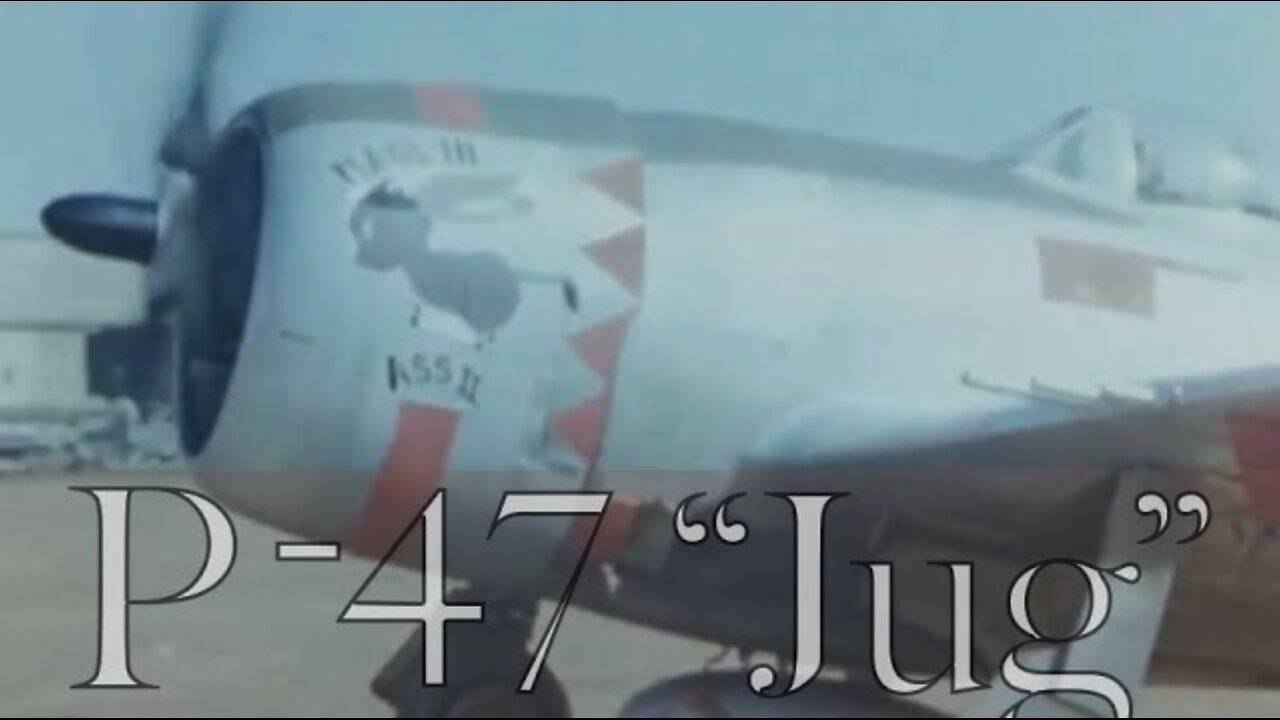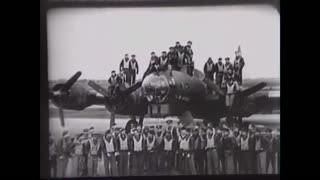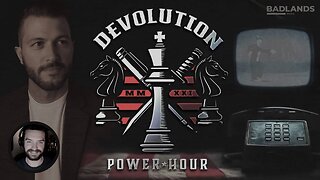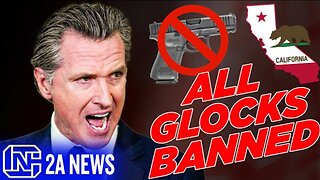Premium Only Content

P-47 "Jug" FORWARD AIRFIELD from 1945 (George Stevens) & Luftwaffe He-111 training film from 1943
🔥PREVIEW ALL YOUTUBE VIDEOS
www.Patreon.com/Military1945
Episode 242
ORIGINALS for sale...
https://www.militaria1945.com
The Republic P-47 Thunderbolt is a World War II-era fighter aircraft produced by the American company Republic Aviation from 1941 through 1945. It was a successful high-altitude fighter, and it also served as the foremost American fighter-bomber in the ground-attack role. Its primary armament was eight .50-caliber machine guns, and it could carry 5-inch rockets or a bomb load of 2,500 lb (1,100 kg). When fully loaded, the P-47 weighed up to 8 tons, making it one of the heaviest fighters of the war.
The Thunderbolt was effective as a short- to medium-range escort fighter in high-altitude air-to-air combat and ground attack in both the European and Pacific theaters. The P-47 was designed around the powerful Pratt & Whitney R-2800 Double Wasp 18-cylinder radial engine, which also powered two U.S. Navy/U.S. Marine Corps fighters, the Grumman F6F Hellcat and the Vought F4U Corsair. An advanced turbosupercharger system ensured the aircraft's eventual dominance at high altitudes, while also influencing its size and design.
The P-47 was one of the main United States Army Air Forces (USAAF) fighters of World War II. It also served with other Allied air forces, including those of France, the United Kingdom, and the Soviet Union. Mexican and Brazilian squadrons.
The armored cockpit was relatively roomy and comfortable and the bubble canopy introduced on the P-47D offered good visibility. Nicknamed the "Jug" owing to its appearance if stood on its nose, the P-47 was noted for its firepower and its ability to resist battle damage and remain airworthy.
By the end of 1942, P-47Cs were sent to England for combat operations. The initial Thunderbolt flyers, 56th Fighter Group, were sent overseas to join the 8th Air Force. As the P-47 Thunderbolt worked up to operational status, it gained a nickname: "Jug" (because its profile was similar to that of a common milk jug of the time). Two fighter groups already stationed in England began introducing the Jugs in January 1943 - the Spitfire-flying 4th Fighter Group, a unit built around a core of experienced American pilots who had flown in the RAF Eagle Squadrons prior to the US entry in the war; and the 78th Fighter Group, formerly flying P-38 Lightnings.
The first P-47 combat mission took place 10 March 1943 when the 4th FG took their aircraft on a fighter sweep over France. The mission was a failure due to radio malfunctions. All P-47s were refitted with British radios, and missions resumed 8 April. The first P-47 air combat took place 15 April with Major Don Blakeslee of the 4th FG scoring the Thunderbolt's first air victory (against a Focke-Wulf Fw 190).
By mid-1943, the Jug was also in service with the 12th Air Force in Italy and against the Japanese in the Pacific, with the 348th Fighter Group flying missions out of Port Moresby, New Guinea. By 1944, the Thunderbolt was in combat with the USAAF in all its operational theaters except Alaska.
Luftwaffe ace Heinz Bär said that the P-47 "could absorb an astounding amount of lead [from shooting at it] and had to be handled very carefully". Although the North American P-51 Mustang replaced the P-47 in the long-range escort role in Europe, the Thunderbolt still ended the war with an aerial kill ratio of 4.6:1 in over 746,000 sorties of all types, at the cost of 3,499 P-47s to all causes in combat. By the end of the war, the 56th FG was the only 8th Air Force unit still flying the P-47, by preference, instead of the P-51. The unit claimed 677-1/2 air victories and 311 ground kills, at the cost of 128 aircraft. Lieutenant Colonel Francis S. Gabreski scored 28 victories, Captain Robert S. Johnson scored 27 (with one unconfirmed probable kill leading to some giving his tally as 28), and 56th FG Commanding Officer Colonel Hubert Zemke scored 17.75 kills. Despite being the sole remaining P-47 group in the 8th Air Force, the 56th FG remained its top-scoring group in aerial victories throughout the war.
With increases in fuel capacity as the type was refined, the range of escort missions over Europe steadily increased until the P-47 was able to accompany bombers in raids all the way into Germany. On the way back from the raids, pilots shot up ground targets of opportunity, and also used belly shackles to carry bombs on short-range missions, which led to the realization that the P-47 could perform a dual function on escort missions as a fighter-bomber. Even with its complicated turbosupercharger system, its sturdy airframe and tough radial engine could absorb significant damage and still return home.
-
 8:25
8:25
Military1945
6 months agoDie Wehrmacht 1944 Nr 4 Pt 2 - Air Defence - Flak 88 - FW 190 - Me 109 - Goering - 8th Air Force
1631 -
 LIVE
LIVE
FreshandFit
11 hours agoAfter Hours w/ Girls
7,617 watching -
 2:07:44
2:07:44
Inverted World Live
6 hours agoPentagon Says it Solved UFO Cases, Tyler Robinson "Roommate" Missing | Ep. 113
34.6K14 -
 2:30:00
2:30:00
Badlands Media
12 hours agoDevolution Power Hour Ep. 392: Psyops, Paper Tigers, and the Path to Sovereignty
86.8K14 -
 3:02:08
3:02:08
TimcastIRL
7 hours agoLeftist Terror Attack On ICE In Dallas, Jimmy Kimmel Doubles Down Insulting MAGA | Timcast IRL
344K140 -
 1:17:35
1:17:35
Man in America
12 hours agoIs Starlink RIPPING Us Apart from the Inside Out? w/ Cory Hillis
47.5K15 -
 55:40
55:40
TheSaltyCracker
6 hours agoIdiots Chug Tylenol PT2 ReeEEStream 9-24-25
107K224 -
 5:55:01
5:55:01
Akademiks
7 hours agoYoung Thug Dissing YFN Lucci. Ready to Go back to Jail. Offset vs Cardi b
65.2K4 -
 7:07
7:07
Colion Noir
15 hours agoCalifornia Just Banned All Glocks
55.8K40 -

Adam Does Movies
8 hours ago $1.17 earnedTalking Movies + Ask Me Anything - LIVE
46K1